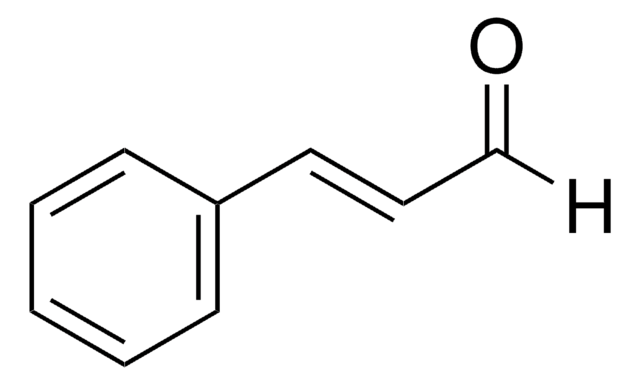모든 사진(1)
About This Item
Linear Formula:
(CH3)2CHC6H3(CH3)OH
CAS Number:
Molecular Weight:
150.22
FEMA Number:
2245
Beilstein:
1860514
EC Number:
유럽평의회 번호:
2055
MDL number:
UNSPSC 코드:
12164502
PubChem Substance ID:
플래비스(Flavis) 번호:
4.031
NACRES:
NA.21
추천 제품
Grade
FG
Fragrance grade
Halal
Kosher
natural
Quality Level
Agency
follows IFRA guidelines
meets purity specifications of JECFA
규정 준수
EU Regulation 1223/2009
EU Regulation 1334/2008 & 178/2002
FDA 21 CFR 117
분석
99%
refractive index
n20/D 1.522 (lit.)
bp
236-237 °C (lit.)
mp
3-4 °C (lit.)
density
0.976 g/mL at 20 °C (lit.)
응용 분야
flavors and fragrances
문건
see Safety & Documentation for available documents
식품 알레르기항원
no known allergens
향수 알레르기항원
carvacrol
감각 수용성의
camphoraceous; woody; spicy
SMILES string
CC(C)c1ccc(C)c(O)c1
InChI
1S/C10H14O/c1-7(2)9-5-4-8(3)10(11)6-9/h4-7,11H,1-3H3
InChI key
RECUKUPTGUEGMW-UHFFFAOYSA-N
유사한 제품을 찾으십니까? 방문 제품 비교 안내
관련 카테고리
일반 설명
Carvacrol is one of the key constituents of basil and thyme essential oils. It is one of the compounds that may be responsible for antioxidant activities of these oils.
애플리케이션
- Prophylactic efficacy of baicalin and carvacrol against Salmonella Typhimurium biofilm on food and food contact surfaces.: The study explores the effectiveness of carvacrol in preventing biofilm formation by Salmonella Typhimurium, with implications for food safety (Ashrafudoulla et al., 2024).
신호어
Danger
유해 및 위험 성명서
Hazard Classifications
Acute Tox. 4 Oral - Aquatic Chronic 2 - Eye Dam. 1 - Skin Corr. 1B
Storage Class Code
8A - Combustible corrosive hazardous materials
WGK
WGK 3
Flash Point (°F)
>212.0 °F
Flash Point (°C)
> 100 °C
이미 열람한 고객
Identification of volatile components in basil (Ocimum basilicum L.) and thyme leaves (Thymus vulgaris L.) and their antioxidant properties.
Lee SJ, et al.
Food Chemistry, 91(1), 131-137 (2005)
Yuhua Chang et al.
Journal of agricultural and food chemistry, 61(37), 8906-8913 (2013-09-04)
A simple cost-effective method (spontaneous emulsification) for fabricating physically stable antimicrobial nanoemulsions from essential oils is described. These nanoemulsions (10 wt % total oil phase) were formed by titration of a mixture of essential oil (carvacrol), carrier oil (medium chain
Samed Koc et al.
Veterinary parasitology, 193(1-3), 316-319 (2012-12-12)
The acaricidal activity of an essential oil obtained from aerial parts of Origanum bilgeri P.H. Davis (Lamiaceae), an endemic species in Turkey, and its major constituents, carvacrol was evaluated against unfed adults Rhipicephalus turanicus Pomerantzev (Acari: Ixodidae) collected from Kepez
Josué de Moraes et al.
Parasitology research, 112(2), 603-610 (2012-10-23)
Blood flukes of the genus Schistosoma are the causative agents of human schistosomiasis, a debilitating disease that afflicts over 200 million people worldwide. Praziquantel is the drug of choice but concerns over praziquantel resistance have renewed interest in the search
Wei-Zhe Liang et al.
Toxicology, 303, 152-161 (2012-11-14)
Carvacrol is one of the main substances of essential oil which triggers intracellular Ca(2+) mobilization and causes cytotoxicity in diverse cell models. However, the mechanism of carvacrol-induced Ca(2+) movement and cytotoxicity is not fully understood. This study examined the effect
Global Trade Item Number
| SKU | GTIN |
|---|---|
| W224511-100G-K | 4061838115409 |
| W224511-10KG-K | 4061838256737 |
| W224511-1KG-K | 4061838093202 |
| W224511-SAMPLE-K | 4061837509049 |
자사의 과학자팀은 생명 과학, 재료 과학, 화학 합성, 크로마토그래피, 분석 및 기타 많은 영역을 포함한 모든 과학 분야에 경험이 있습니다..
고객지원팀으로 연락바랍니다.








